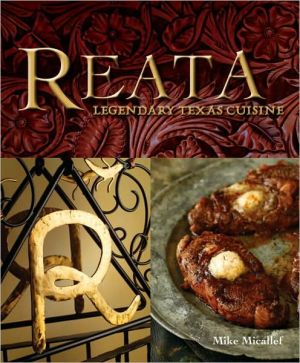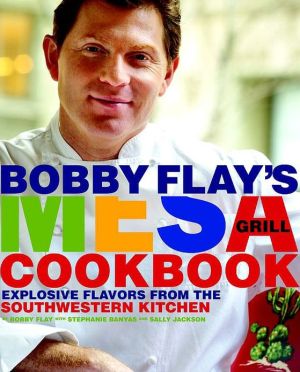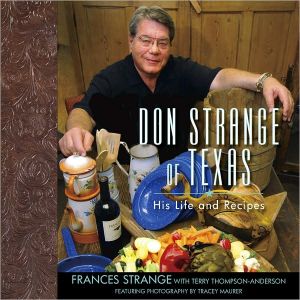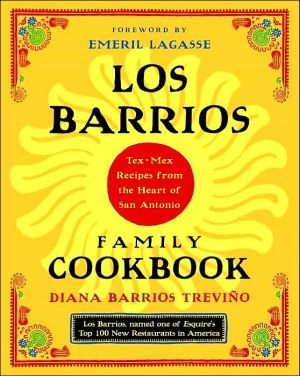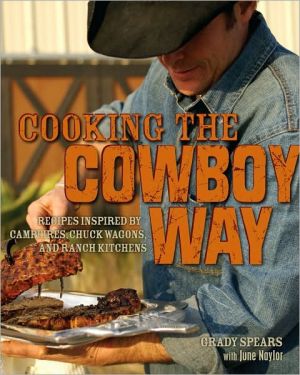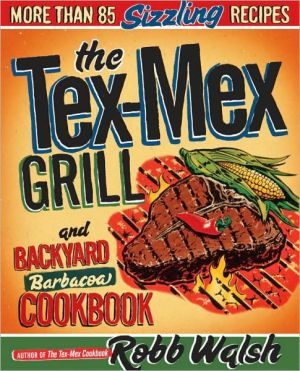Reata: Legendary Texas Cooking
Bold. Majestic. Storied. Texas.\ The Lone Star State has many traditions, among them its homegrown cuisine, which Texans have always been justly proud of, and which has been gaining followers—and respect—all over the country. The Reata restaurants have an honored place in this emerging culinary story. Reata: Legendary Texas Cuisine tells the tale of one American family that, against the breathtaking backdrop of Texas, took risks, worked hard, and dreamed big.\ \ Today...
Search in google:
Bold. Majestic. Storied. Texas. The Lone Star State has many traditions, among them its homegrown cuisine, which Texans have always been justly proud of, and which has been gaining followers—and respect—all over the country. The Reata restaurants have an honored place in this emerging culinary story. Reata: Legendary Texas Cuisine tells the tale of one American family that, against the breathtaking backdrop of Texas, took risks, worked hard, and dreamed big. Today the pride of the Micallef family are its two Reata restaurants, the original location in the tiny West Texas town of Alpine, and its much larger sibling in Fort Worth. Reata pays homage to America’s cowboys and the values they have come to symbolize by promoting the traditional ideals of integrity, generosity, and hospitality with an easy ambience, exciting dishes, and exceptional service. The Reata menus combine familiar Texas fare with fresh culinary trends, including signature favorites, like the pepper-crusted tenderloin, the golden chicken-fried steaks, and the tenderloin tamales. Adventurous cooks will want to try the buffalo rib eye and the smoked quail, as well as some of the more surprising pairings, such as the boar ribs with a Thai-inspired spicy peanut dipping sauce. And no Reata cookbook would be complete without the fiery jalapeño cheese grits or the unrivaled “Giant” onion rings. So if you can’t drop by one of the restaurants and set a spell, Reata: Legendary Texas Cuisine will give you a taste of Reata that’s as big and bold as the state of Texas itself.
INTRODUCTION\ \ When you roll into a new town and step out of your pickup to stretch your legs, you might look to the east and then to the west, but what if nowhere in sight can you spy a promising place to eat? Perhaps you settle for the local greasy spoon, or maybe you climb back in your rig and head on down the highway to the next town. Not my dad. He had just bought the ranch of his dreams in the Davis Mountains of West Texas, and as he saw it, there was only one thing missing. With no great restaurant in Alpine, he identified a business opportunity. But I’m getting seriously ahead of myself.\ \ In the spirit of that wonderful old bumper sticker, my dad wasn’t born in Texas but he got here as quick as he could. No, let me take that back. I believe that in some profound way, my father, Al Micallef, was born to be a Texan. When he was a boy, he read books about Texas and saw movies about Texas—many of them the cowboy-and-Indian shoot-em-ups that were standard issue for an American male growing up in the 1940s. He even curled up at night beside an old crystal radio, listening to “border-blaster” radio broadcasts from just across the Rio Grande River, the border between Texas and Mexico. Cowboys and Indians, sheriffs and outlaws, pirate broadcasters, and wildcat oilmen—these weren’t just characters in stories to my dad as a child in Detroit, of all the unlikely places. In time, they were my dad. It was his destiny to become a Texan.\ \ This book, about the glorious cuisine of the Lone Star State, is also the story of one American family who did, on the giant canvas that is Texas, what American families have always done: sought to make life a little better by taking risks and working hard. Today, our family is most visible in its Reata restaurants, the original in the tiny West Texas town of Alpine, and its much larger sibling in the increasingly sophisticated “cowtown” of Fort Worth.\ \ Long before Texas meant gushing oil, JR Ewing, or the Dallas Cowboys, it meant steers on the open range. And it took rugged men unafraid of huge risks to take on Mother Nature and just about everybody else to raise cattle. This history has nurtured an attitude held by many Texans of entrepreneurship, those individuals seeing new opportunities and not afraid to bet the farm—or the ranch—on their next great idea. My father has that entrepreneurial DNA, with a dozen or more other enterprises in which he saw some beckoning opportunity. Truth is, Al Micallef never did anything halfway—he still doesn’t. His life in Texas, and by association all our family’s lives here, began with that most classic of Texas dreams: the cattle ranch.\ \ This spirit is Texas to us, and it’s Texas to millions of others today who have many colors of skin, who follow many faith traditions, who speak many languages. Together, I think I can say, we all want the same thing from this book you’re holding in your hands—for you to come to know and love our Texas and her traditions just the way we do.\ \ \ Gone to Texas\ \ Even for those of us who arrived much later, the words “Gone to Texas” have had special meaning since the early 1830s. It was in those years, when today’s state was Mexican territory remaining from Spain’s colonial empire, that the call for new settlers was answered all over the young country known as America. History tells us that folks simply packed up their houses and businesses, pointed their wagons west, and left behind only a hand-lettered sign over the door or nailed to the front gate: “Gone to Texas.” That was all it said. It said a mouthful.\ \ And it still does.\ \ By the mid-1970s, had those settlers managed to stick around, they surely wouldn’t have recognized the place. Beginning with momentous discoveries in the early twentieth century, Texas had become an oil and gas empire with considerable affluence and many jobs to spread around. High technology, such as it was back then, had come to Texas with NASA under Lyndon Johnson’s space program and dug in as Texas Instruments and a few other early “computer” companies. No one knew it yet, but the business forces that would one day make Austin a technology powerhouse were beginning to transform Texas from within. So of course, my dad had to go and get all revved up not about oil and gas, not about calculators or computers, but about good, old-fashioned Texas cattle.\ \ By 1975, shortly before the birth that would make me a native Texan, my father moved his family from Detroit to Fort Worth. As a business prodigy, he had risen to the upper management of a manufacturing firm at the age of twenty-four and decided, in hopes of becoming a cattle rancher too, that the company should essentially post their own “Gone to Texas” sign. Before long, the manufacturing company had a new home and the Micallef family had embarked on a series of successful cattle ventures in the Fort Worth area. Our first ranch, on the Clear Fork of the Trinity River, took on the name CF. In a state that understood the value of branding cattle long before Madison Avenue made branding an all-encompassing concept, the CF Ranch was born.\ \ As we discovered over the years, while our family grew with the arrival of my two sisters, Amanda and Sarah, so did Dad’s ambition. Ranching on the green prairies of northeast Texas was one thing. Ranching on the dry, brown, and gray volcanic rock of West Texas was something else entirely. Still, my parents had visited friends in this area and soon found themselves thinking about another big gamble. In 1992, they signed papers to purchase what became our headquarters ranch north of Alpine, in the heart of the majestic Davis Mountains. Over time Dad added other ranches south of Alpine, between Van Horn and Sierra Blanca, and in northeastern New Mexico.\ \ Cattle ranching was very lucrative in the past, but today you can’t pay for a ranch by just raising cattle. At one time, we had more than 150,000 acres, and in fact I remember one of my sisters asking Dad if he intended to buy all the land in Texas. “No, just everything that borders mine,” he said with his trademark Al Micallef grin. Today, that number is reduced to some degree, much of it used for our cattle but some devoted to polo ponies and now to thoroughbreds. To share the beauty and splendor of the area, we’ve introduced some of the South Ranch to a residential development—large 20- to 30-acre spreads that we lease back to graze our cattle.\ \ Ranching has been very good to my family, but there also hasn’t been a single day that we, my dad in particular, haven’t worked to do our jobs better. Today ranching is a business like any other, except that we get to work in the outdoors and see things people from cities can only dream of. The Ranch Management School at Texas Christian University began in 1956 and teaches students the day-to-day management of a working ranch, but it also instills a work ethic and attitude that you have to adapt to a constantly changing environment—or perish. I graduated with a Certificate in Ranch Management from TCU in 1997 and a BBA⁄Finance in 1999.\ \ My father and I have searched out other activities we can do on the ranch with minimal impact to the land, our most valuable asset. Hunting is an important source of income for ranches these days, and in some places it has exceeded cattle revenues. Our ranch has been a popular location for shooting print ads, movies, TV shows, and music videos: The Good Old Boys, Streets of Laredo, Dead Man’s Walk, Rough Riders, Dancer Texas, Grand Champion, Cowboy U, and a Brooks & Dunn video, A Man This Lonely, just to name a few.\ \ Even if you didn’t already know what this book is about, you might see where this is all leading: managing Mother Nature to harvest one of its most popular foods, carefully balancing cost with revenue to make a fair profit, embracing the hospitality and entertainment industries almost as though they’re the same—and of course doing what many do for romance or fun, but doing it seriously for a living. Still, to hear my father tell it, he didn’t open the original Reata for any of these reasons. He propelled his family into the restaurant business because he kept turning up in Alpine and couldn’t find anything good to eat.\ \ \ The Original Reata\ \ Over the years, talking with customers in both our Alpine and Fort Worth locations, I’ve been struck by how many non-Texans (and even some Texans) are surprised by the diversity of our “cowboy cuisine.” In a way, though, this makes perfect sense—as many are even more surprised by the diversity of our cowboys.\ \ Thanks to Hollywood, just about everybody thinks they know what a Texas cowboy is: how he dresses, how he talks, even how he moves and thinks. Yet few people understand how many centuries and how many ethnic groups fed into that single Hollywood stereotype. Few of the early Texas cowboys, for instance, spoke with that familiar “howdy pardner” Texas twang—because they were busy speaking Spanish. That explains why, going back even before the Republic of Texas was founded in 1836, a majority of our most beloved foods bore and still bear the signatures of the Spanish and Mexican empires. Furthermore, many of our cowboys didn’t have deep, red-tinged suntans—because they happened to be African Americans, either former slaves or members of an elite cavalry force known as the Buffalo Soldiers. Texas, you understand, both had and was its own Ellis Island. Its very beginnings cried out for the bravest settlers, and/or the ones with the least to lose—the best, you might say, if not always the brightest. We even had our own port, Galveston, through which tens of thousands of immigrants poured from places like Sicily and Bohemia, even from Japan and China. Our Sicilians tended to become farmers and migrated to the rich-soiled southeast, while Germans, Czechs, and other middle Europeans congregated in the rockier Hill Country, their talents as butchers giving America the beginnings of Texas barbecue. Hispanic Texans always tended to live in the places they felt most comfortable, meaning the Rio Grande Valley that stretched from the Gulf of Mexico all the way west to the settlement known as El Paso del Norte (or El Paso for short).\ \ Before the Republic, during our independence, and finally as America’s 28th state, there were no hard-and-fast borders between these ethnic groups. They mixed and mingled, of necessity mostly but sometimes by choice, doing business, protecting themselves from frontier threats, and marrying each other’s daughters. Honestly, while some people think they know what a Texas meal should taste like, almost any meal can be a Texas meal. And that’s part of what we Texans are most proud of.\ \ My dad, still hungry, quickly found that Holy Trinity of the restaurant business in Alpine—location, location, location—establishing his eatery downtown in an old adobe house from the 1880s. He was inspired in every decision, it seems, by the fact that décor and cuisine came together in a setting authentically and historically associated with the people whose memory we were honoring. We worked with a decorator here and there, with a trained chef here and there too, but the vision of Reata was always my father’s. What he wanted, and what we want now, is a damn good place to eat. We believe the best way to achieve that is with a great attitude and an innovative celebration of Texas culinary history—a menu that’s free of the deprivation that was typical for cowboy cooks yet that would build every single flavor from something Texans have loved for generations.\ \ The name Dad chose for our family’s restaurant was something of a natural, yet definitely a stroke of genius as well. The word reata is Spanish for “rope,” and there couldn’t be a more basic, essential tool for the cowboy than that. You simply can’t go about ranchin’ without one. Yet the name, from the beginning, drew upon the mystique of another, less workaday West Texas icon. Reata had been the name of the ranch, the homestead—the Tara, if you will—in the myth-spinning 1956 film Giant, based on the Edna Ferber novel. The movie starred Elizabeth Taylor, Rock Hudson, and James Dean and was released only two weeks before Dean was killed in a car wreck. Filmed about 20 miles away from Alpine in the vicinity of Marfa, Giant set the tone for fictional treatments of Texas ranch families for decades to come. In other words, with the name my father chose for our restaurant, we were drawing together everything that was real about Texas ranch life and everything that was legendary as well.\ \ Even with our strong grounding in Texas food, we still had to grapple with what would be one of our biggest challenges: the importance of our chef. On the one hand, we knew what we wanted to see and taste on each plate—and that meant nothing frou-frou, nothing wimpy, nothing out of character here in Texas. But we also launched the first Reata at the dawn of the Era of the Superstar Chef, when the guys who used to simply make our meals would evolve into guys who would make millions, front namesake restaurants in Las Vegas, and entertain us on the Food Network. Truth is, we worked with a string of talented chefs at Reata and they received national media attention, but we’ve made the decision that it’s more important to concentrate on the customer and have all of our chefs in Reata’s kitchen, creating your next meal and experience. Today, whenever people ask us about our chefs, we tell them instead about our family: about our long experience on a real Texas cattle ranch, about our profound understanding of Texas people, Texas history, and our team at Reata. Dad has always said you have to stay close to your roots.\ \ \ Brave New World\ \ If you think it ever gets easy in the restaurant business—even when you have one operation running smoothly—then you haven’t heard about our efforts to bring Reata to Fort Worth. The city has embraced our food since day one, we are grateful to report; but a series of unlikely and even tragic events taught us the age-old truth that what doesn’t destroy you makes you stronger.\ \ Reata in tiny Alpine, Texas, was a huge hit. We had customers coming in from all over the state, people who never imagined they’d come all the way to Alpine for a meal. And they sat right down under the row of cowboy hats (hung on the wall by working cowboys) and dug in to the pleasures of our food with gusto. Thanks to my father’s essential notions about what would work at Reata, as well as contributions from our gifted chefs, our menu had taken exciting shape. Over time we found a motto to suit our mission: REATA: Legendary. Texas. Cuisine.\ \ For instance, we knew our customers would want a good steak; and of course, as cattle ranchers, we were more than happy to supply them with one. Yet the traditional American steakhouse fare of red meat with baked potatoes and creamed spinach wasn’t good enough for Reata, not for what we had in mind. We served (and still serve, as one of our signature entrées) pan-seared pepper-crusted tenderloin with port wine sauce. Or for those wishing a surprise from farther south, we have carne asada topped with what some call the best cheese enchiladas anywhere. I’m not sure where the idea of covering steak with enchiladas came from exactly, but after you try our rendition, you’ll want to move there. Around these and other beef-centric favorites grew a ceaselessly creative swirl of starters, sides, and desserts. Personally, I don’t eat anything I use for bait, but even some seafood was allowed in!\ \ Our customers couldn’t get enough of our tenderloin tamales with pecan mash, and even ventured to sample our calf fries with cream gravy—we’ve been told we’re America’s largest seller of calf fries, which must be some kind of honor. Those seeking lighter fare fell in love with our totally trans-Pecos wedge salad with pico vinaigrette and crumbled bleu cheese, while lunch crowds packed in for our club sandwich with hand-cut fries or our equally eye-popping BLT, made with peppered apple-smoked bacon. No matter how stuffed they claimed they were after their entrée, nobody ever seemed to hit the door without indulging in a signature dessert like our chocolate chunk bread pudding tamale (yes, it comes wrapped in a corn husk!) or our country-goes-decadent West Texas pecan pie.\ \ We took these and a host of other dishes to our brand-new venture on the 35th floor of the Bank One Tower in Fort Worth, invited there by a close family friend and Fort Worth banker Bob Semple after he visited Reata Alpine. We understood that Fort Worth, or Cowtown, to us locals for its romanticized past of stockyards, cattle drives, and gunfights always inspired by women, whiskey, or both, was a much bigger and, in many ways, more demanding city. Obviously, there would be more competition for diners on any given night than there’d be in a month or even a year in our little West Texas town. But we were confident of our cooking, of our hard-won philosophies of wine and service, and (within reason) of the praise we’d received from local, regional, and national media. And my dad kept us sane. Despite his passion for every venture he undertook, he insisted on solid business principles and careful growth. When people say that most new restaurants fail within the first year or two, I’m pretty sure some of them wouldn’t fail if they had my dad to keep their heads on straight.\ \ Yet even a straight head can’t save you from fate. On March 28, 2000, as on any other evening in the Bank One Tower, all was ready for dinner and we had begun seating guests. In a matter of minutes, however, everything we knew and counted on changed forever.\ \ A funnel cloud began to spin mightily, and the skies turned an ominous green. The emergency sirens began to wail, and at 6:20 p.m., a whopper of a tornado hit downtown Fort Worth right in the gut.\ \ Described by a long-time local media professional as “the most strange and indiscriminate tornado ever seen,” an F2 tornado struck the very heart of the city, shattering high-rise buildings and collapsing whole neighborhoods along a two-mile path.\ \ The first deadly twister in Fort Worth’s history killed four people and injured more than a hundred others. City officials closed large segments of downtown for days to make the area safe for pedestrians. Weeks later, experts assessed the damage to Fort Worth at more than $450 million.\ \ The heart of the city looked like a war zone; our restaurant was torn to shreds. Our staff barely had enough time to get our guests and themselves to safety in the fire exit stairwell. The floor-to-ceiling windows blew out, furniture spun through the air, and even the heaviest pieces of kitchen equipment went airborne. There are wild security videotapes of all this, and every time I watch them for a few moments I am amazed by the miracle that no one in Reata was killed.\ \ We spent much of that night making sure every single one of our staff and guests were safe and back in the arms of loved ones, and also securing what was left of the Fort Worth Reata as best we could. By the next day, we had decided to rebuild. After all, we had a following from all over the Dallas-Fort Worth metroplex who knew where to find us, and the many businesses that shared our high-rise would depend on us to be there as they sought normalcy in the face of extremely abnormal circumstances.\ \ In forty-two days following the tornado, with then-Reata president Mike Evans at the helm, we poured more than $1 million into the Herculean task of rebuilding and reopening. We brought back 100 percent of the staff, feeling that was simply the right thing to do for those who had sacrificed so much. What’s more amazing, even as they were helping us rebuild, we knew that many of them were also volunteering with the Red Cross and other relief organizations, reaching out to other tornado victims in our own building and beyond.\ \ To the astonishment of all, Reata reopened for business on May 9, 2000, with its menu and staff intact. The tornado and its after effects created hardship for not only Reata but also an entire city. Reata quickly became an example of what could be accomplished in a short period of time when a team comes together. Nevertheless, in January of 2001 we were forced to close. We made the announcement, and three days later we served our last meal. And those three days were the busiest we had experienced to date. We were touched by how emotional our guests were, knowing that their Reata was closing. It was a nonstop party, with as many toasts to the future as there were reminiscences about the great times from the past.\ \ \ The Bright Road Ahead\ \ Though I’m often told that clouds have silver linings, you might excuse me if I don’t extend that axiom to funnel clouds. Still, there was a silver lining of sorts. As always, with Dad’s style of hard-nosed business thinking, we realized something about what was lost in Fort Worth—and turned it into something found. We had a tremendously loyal family of employees, we had some terrific recipes, and we had a good-as-gold reputation with our customers. What we didn’t have was a place for people to come visit us. Like a phoenix born from the ashes, Reata on the Road was born.\ \ We’d done a little catering before, of course, as almost every restaurant ends up doing some from time to time. But we’d been too busy opening and running two restaurants 480 miles apart to give it our full attention. Now we could, and now we did. Utilizing a 3,000-square-foot catering kitchen, we took an extreme leap of faith into the world of private and corporate catering, cooking classes, and full-scale event production. Like our Reata menu was and is, Reata on the Road was everything we expected—and then some.\ \ It’s hard for me to look back at those days without remembering a phrase Dad always says, “If you’re not making dust, you’re eating dust.” We took on any challenge that presented itself. And after what we’d been through with the tornado, cooking or transporting food just about anywhere seemed, well, small potatoes. Catering really allows you to get close to your customers. It got us deeply involved in our community with events ranging from the Main Street Fort Worth Arts Festival to one of our most treasured relationships, the Fort Worth Stock Show and Rodeo.\ \ Since 1896 there has been an annual livestock show in Fort Worth, and since 2002 Reata has operated a full-service restaurant at this event, Reata at the Rodeo. In the beginning, Reata had just one dining room that was decorated to have the look and feel of our first Fort Worth home on the 35th Floor of the Bank One building. With nothing more than a tent to cook in and a staff that exceeded expectations, we served all the same favorites from the Reata menu, including the pan-seared pepper-crusted tenderloin and the quail with jalapeño cheese grits, and our reservation book was always filled. In the years that followed, we added a second room trying to quell the demand, but our only problem was how to accommodate all of our customers. After the 2007 rodeo, we were asked to take over the Backstage Club, an area that has been operated as a private club since the 1950s and that overlooks the rodeo arena.\ \ This was a huge undertaking. We remodeled the space, building a whole new restaurant just for those three weeks of the rodeo. We were thrilled by the demand for memberships, recognition that patrons supported the product we were offering. We had 386 memberships before we were forced to stop selling; we simply had no reservation times left. By the end of the rodeo we had an additional 225 folks on the waiting list for memberships for the coming year. Having Reata at the Rodeo and Reata at Backstage, totaling 400 seats, while still running our flagship restaurants sure shows what a team can really do. We strive to offer the finest dining experience found at any rodeo, or for that matter at any top-level sporting event in the country.\ \ Everybody who’s ever visited Forth Worth knows about Sundance Square, named after a man even more colorful than my dad, the notorious outlaw, the Sundance Kid, who rode with the equally infamous Butch Cassidy. It’s the city’s chief dining and entertainment district, a stylish swirl of restaurants, bars, nightclubs, and music venues in a remarkable historic setting. As an urban redevelopment project, Sundance Square had been spearheaded since the early 1980s by local businessman and philanthropist Edward P. Bass. By the time we entered the picture, Sundance had a huge space that was crying out to be something wonderful. Lately occupied by a nightclub called Caravan of Dreams, it was no less than 22,000 square feet of intriguing components that included a recording studio, a theater, two dance spaces, a rooftop cactus garden, and a geodesic glass dome. What a challenge this location would be, and what an incredible opportunity.\ \ Whereas many restaurants are essentially composed of a single room with a uniform look, Reata at Sundance would be much, much more. We are grateful to designer Carla Curry for helping us understand and embrace the many different spaces we have. Each area would have its own special signature, and each would be unforgettable. The motif that connects all the dots, however, is, just as it had been with the first Reata in Alpine, my family’s love of the Old West. Reata at Sundance today is filled with museum-quality antiques and historical artifacts and memorabilia that celebrate the American cowboy, an icon that has become deeply rooted in our country’s collective imagination. Photos of Texas ranches are part of the Reata experience, as are the spectacular silver saddles used in past Rose Bowl Parades and the chaps worn by the late Dan Blocker (unforgettable as Hoss Cartwright on the beloved TV show Bonanza), who attended Sul Ross State University in Alpine.\ \ With kitchens on three levels and a much larger staff, we’ve been able to expand our menu beyond the list offered in Alpine—in fact, we now use Fort Worth to develop new recipes to be served in both restaurants. Spotting an opportunity, we were able to build a number of private dining rooms, large and small, into Reata at Sundance. Today, private dining accounts for 30 percent or more of our business at certain times of the year. It’s exciting for a restaurant to be chosen when there’s so much competition for business meetings, wedding engagements and rehearsal dinners, anniversary and retirement parties, and just about every other occasion the people of Fort Worth can think of to celebrate. We are grateful they select all of us at Reata to celebrate right along with them.\ \ Why does Reata continue to grow? Why are we more successful today than at any other time in the past? There isn’t just one answer, but first and foremost, it is that we’re a single team with a single goal: exceed the customer’s expectations.\ \ That experience begins when customers call to make their reservation, when they drop off their car with our valet, when they are greeted and seated by one of our hostesses, and when they are taken care of by our bartenders, servers, managers, chefs, and kitchen staff. Any breakdown in the system can result in the customer’s experience not being perfect. And if that happens, we’ve failed. They say the devil is in the details, and we take the details very seriously. Details like calling a guest a day or two after their meal and asking about the service, the food, and the ambience goes a long way toward perfecting that guest’s experience. So does having the valets place thank-you cards in the vehicles with my phone number and e-mail address so the customer can communicate with me personally.\ \ I know, we’re a restaurant, and I enjoy talking about food. We’ve always used the freshest ingredients possible to make the kind of dishes you wouldn’t mind eating a couple days a week. Each recipe in this book carries interesting descriptions about exactly what we use, how we use it, and why we are so happy with the finished product. But that’s about when you’re dining at our restaurant, and I have an additional endorsement: You may think I’m crazy, but I have personally tested every recipe in my home kitchen with the same kitchen appliances you have in your home. The reason for doing this is when you reduce a recipe that is supposed to feed hundreds to a serving size of six you have to make some adjustments, and that’s just what we did so you would have a wonderful Reata experience with this cookbook. So relax, roll up your sleeves, have some fun, and enjoy the great food.\ \ We have come full circle, you see. Beginning our restaurant journey as a real Texas ranching family, we came to realize that at Reata, in Alpine, Fort Worth, and anywhere we grow from here, every plate and every glass lives in the imagination of each individual customer. Like Giant, the movie that gave us our inspiration and our name, what we’re living each day is life. But what we’re serving, in our restaurants and in all the pages that follow, is something so much larger, something, well, something just—GIANT!
CONTENTS Introduction — ixby John DeMers and Mike Micallef starters – 1soups — 29salads & dressings — 41sides — 57mains — 71 desserts — 109 extras — 129 drinks – 147 Acknowledgments — 160Index — 162
